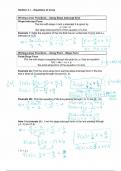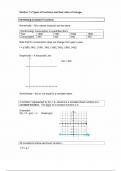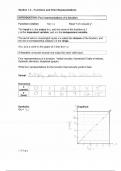Sharmaynecarter
On this page, you find all documents, package deals, and flashcards offered by seller sharmaynecarter.
- 12
- 0
- 1
Community
- Followers
- Following
13 items

point-slope form
Point-Slope Form: The point-slope form is an algebraic representation of a linear function that expresses the relationship between a point on the graph and the slope of the line. It is written as y - y1 = m(x - x1), where (x1, y1) represents a point on the line, and 'm' is the slope. This form is particularly useful for determining the equation of a line when given a point and its slope. Intercepts: Intercepts are points where a line intersects either the x-axis or the y-axis. In linear fun...
- Package deal
- Class notes
- • 6 pages •
Point-Slope Form: The point-slope form is an algebraic representation of a linear function that expresses the relationship between a point on the graph and the slope of the line. It is written as y - y1 = m(x - x1), where (x1, y1) represents a point on the line, and 'm' is the slope. This form is particularly useful for determining the equation of a line when given a point and its slope. Intercepts: Intercepts are points where a line intersects either the x-axis or the y-axis. In linear fun...

introduction to linear functions
Linear functions are a fundamental concept in algebra and mathematics as a whole. They represent a simple yet powerful type of function that exhibits a constant rate of change. A linear function can be expressed in the form f(x) = mx + b, where 'm' represents the slope or rate of change, and 'b' represents the y-intercept.
- Package deal
- Class notes
- • 7 pages •
Linear functions are a fundamental concept in algebra and mathematics as a whole. They represent a simple yet powerful type of function that exhibits a constant rate of change. A linear function can be expressed in the form f(x) = mx + b, where 'm' represents the slope or rate of change, and 'b' represents the y-intercept.

introduction to functions
Verbal Representation: This representation describes a function using words or a verbal description. For example, a verbal representation could state that "the output is twice the input value." Numerical Representation: In this representation, a function is represented using a table of input-output pairs. Each input value is associated with its corresponding output value. For example, a numerical representation could be a table showing the input values 1, 2, 3 and their respective output va...
- Package deal
- Class notes
- • 8 pages •
Verbal Representation: This representation describes a function using words or a verbal description. For example, a verbal representation could state that "the output is twice the input value." Numerical Representation: In this representation, a function is represented using a table of input-output pairs. Each input value is associated with its corresponding output value. For example, a numerical representation could be a table showing the input values 1, 2, 3 and their respective output va...
